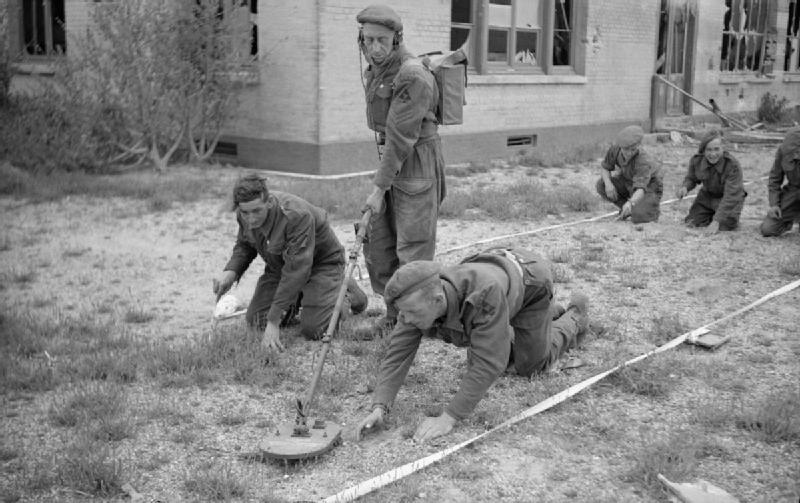
Long after the enemy forces have laid down their arms, peace accords have been signed and victories celebrated, there is still a heavy toll to be paid. Most of this comes in the form of unexploded ordnance, including landmines and the severe pollution from heavy metals and other contaminants that can make large areas risky to lethal to enter. Perhaps the most extreme example of this lasting effect is the Zone Rouge (Red Zone) in France, which immediately after the First World War came to a close comprised 1,200 square kilometers.
Within this zone, contamination with heavy metals is so heavy that some areas do not support life, while unexploded shells – some containing lethal gases – and other unexploded ordnance is found throughout the soil. To this day much of the original area remains off-limits, though injuries from old, but still very potent ordnance are common around its borders. Clean-up of the Zone Rouge is expected to take hundreds of years. Sadly, this a pattern that is repeated throughout much of the world. While European nations stumble over ordnance from its two world wars, nations in Africa, Asia and elsewhere struggle with the legacy from much more recent conflicts.
Currently, in Europe’s most recent battlefield, more mines are being laid, booby traps set and unexploded shells and other ordnance scattered where people used to live. Clearing these areas, to make them safe for a return of their inhabitants has already begun in Ukraine, but just like elsewhere in the world, it is an arduous and highly dangerous process with all too often lethal outcomes.
Boom Later
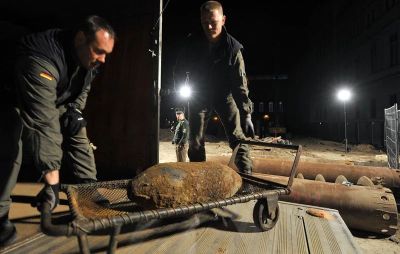
A certain percentage of ordnance – whether in the form of artillery shells or other explosives – fail to detonate upon usage. These duds are an expected occurrence, and since they were not purposely hidden can generally be found fairly easily. Even so, they can be buried centimeters or even meters in the ground, as many an unfortunate farmer near France’s Zone Rouge and similar regions with large concentrations of unexploded ordnance (UXO) has found out. During construction work in Europe it’s not uncommon for large 500 kilogram bombs – originally carried by bomber planes – to be found meters deep in the soil.
While there’s a chance that these duds will remain good at not doing the thing they were designed for, there is also a good chance that the shock of the impact and environmental factors like water ingress may have destabilized them. In 2010 three bomb disposal experts in Germany died while trying to defuse an 1,100 pound WWII Allied bomb, and last year four were injured when another WWII aircraft bomb exploded in Munich, more than sixty years after they were dropped.
Cluster munitions forms a special group in this regard, as this type of ordnance is characterized by a large number (potentially hundreds) of sub-munitions, with generally 1% or more of them failing to detonate. Some of these sub-munitions feature protrusions that enable them to be armed on descent, but as UXO may look like toys to children who will pick them up, often resulting in severe injuries.
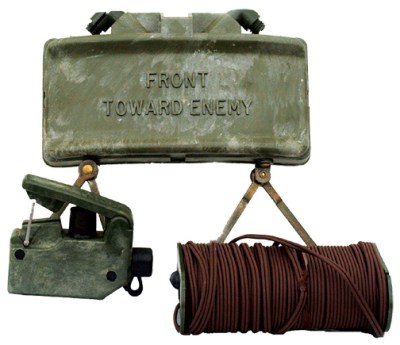
While many of these munitions did not initially detonate due to a manufacturing, deployment or other fault, some are designed to only trigger when certain parameters are met. Landmines are a good example of this, featuring a wide range of configurations. Many are pressure-activated, with anti-tank (AT) landmines requiring a large weight (100+ kg) to push on them before they will trigger, while anti-personnel (AP) mines are much smaller, designed to detonate upon a foot treading on them and containing enough explosives to cause extensive injuries.
The US M18A1 Claymore was designed to propel its payload of metal balls towards the target when triggered remotely or by a tripwire. When set up in e.g. forested areas, mines like these can be hard to spot until the tripwire is triggered. Even more insidious here are bounding mines, which are buried into the soil, but propel the main body of the mine into the air before detonating, injuring or killing anyone within the kill zone. The US AP M16 bounding mine and its many copies can be found in countless former and current war zones.
To complicate matters even further, mines are rarely used only on flat fields, but tend to be used on hill sides, in forests and jungles, alongside rivers and anywhere else where it was perceived that enemy forces would likely pass through. During and after conflicts, mine fields are sometimes subject to floods and other large-scale soil disturbances, which may scatter them across a large area, bury them at various depths and otherwise complicate locating them.
According to UNICEF, 15,000 – 20,000 people in seventy-eight countries are killed or maimed each year by mines, with approximately 80% of them being civilians. Most of these civilians are children.
Facing Danger
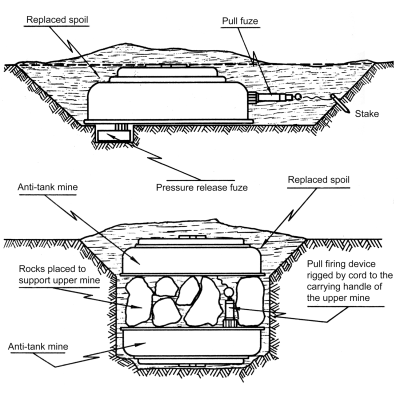
The lower diagram shows two anti-tank landmines connected by a cord attached to the upper mine’s carrying handle. The cord is attached to a pull fuze installed in a secondary fuze well in the bottom mine.
In the process of rendering a former war zone safe for the return of civilians, any UXO has to be tracked down and removed for disposal, or detonated in place. The easiest UXO to find is likely to be the dud shells, cluster sub-ammunition and similar, as these are likely to be lying around, or will have left a clear impact crater to their final depth. Where things get significantly more risky are with booby traps and landmines, as these do not differentiate between a soldier, a civilian or bomb disposal expert.
Some landmines will have anti-handling devices, or a booby trap installed alongside them that will result in detonation when the landmine is lifted up. This makes it crucial to check every single detected landmine for such a booby trap. As such booby traps can consist out of nothing more than a piece of wire connected to the fuze of another mine, hand grenade or other explosive device.
Effectively, this means that finding the UXO is only part of the challenge, even considering that finding especially modern-day minimum metal mines can be exceedingly hard. Whereas older landmine types tend to use metal for the shell and parts of their mechanism, modern-day demining is made significantly harder by denying the use of tools like metal detectors. Even for regular landmines, the use of a metal detector is no guarantee for detection. Especially in soil rich in iron, or metal debris, the effectiveness of a metal detector can be 75% or less.
At its core, demining is done by first checking for tripwires, then by checking the area with a metal detector, followed by a prodding stick that is inserted at a shallow angle. With a bit of luck the prodding stick will hit the side of a landmine, after which it can be dug out and neutralized. Naturally, if the soil has shifted, or if the mine was roughly inserted by mine-laying machines and kin, the mine may be positioned at an angle, in which case the prodding stick may trigger the mine if enough pressure is exerted.
A Helping Paw
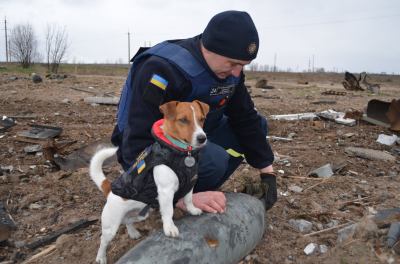
With their sensitive sense of smell, dogs can be trained to detect the chemicals released by the explosives within a mine, as well as other distinctive components. These mine-detection dogs can significantly speed up the pace of clearing an area of UXO, though factors like the foliage density and the climate can impede them.
Although new detection methods are under development – including ground-penetrating radar and various types of infrared and x-ray-based methods – the most reliable and most effective method to definitely clear an area of virtually all mines is still to send out a group of people with prodding sticks, metal detectors and sniffing dogs.
What complicates matters is that not all landmines are the same, with a wide range of explosives, detonators and cases in use. The soil that they’re placed in will also affect how effective certain detection methods are, which may affect the amount of vapors from the explosives that leak out of the soil or the emission spectrum when imaged at certain electromagnetic frequencies.
This is where ground-penetrating radar is perhaps the most promising as a universal mine-detection method, even if it suffers from signal attenuation from e.g. moisture in the soil (limiting the effective detection depth), and its resolution is not high enough to make out details. Even so, radar combined with a metal detector in the form of the Handheld Standoff Mine Detection System (HSTAMIDS) has been in standard use for mine detection by the US Army since 2006.
During trials in Cambodia for humanitarian demining, it was found that it demonstrated quite good performance across soil types, although below 100% detection. The similar, but commercially available dual-sensor Cobham VMR3 Minehound is also seeing limited uptake for demining. In a 2014 article by Cobham on the usage of the VMR2 revision of this detector in Afghanistan and Cambodia it is described how the system is used in these countries, and what the performance is like.
Issues noted were poor performance around rocky ground, as GPR requires the detector head to be moved fairly close to the ground, and old soil disturbances can complicate interpreting the GPR signal. Even so, the ability to combine metal detector readings with GPR signals proved to be highly beneficial. Although it may not be the ultimate detector for highlighting every landmine in the ground, it is yet another useful tool alongside a prodding stick and man’s best friend.
With an accident per roughly every 1,500 cleared mines, demining is a hazardous occupation. Considering the hundred or more years of work that are still ahead to clear even existing minefields, any new tool and technology that can improve detection and overall safely is more than welcome.
[Heading image: Sappers clearing the last mines from the beach front of a former French luxury hotel, now in use as a rest club for troops of 3rd Division, 15 July 1944.]
The Long Tail Of War: Finding Unexploded Ordnance Before It Finds Us
Source: Manila Flash Report
0 Comments